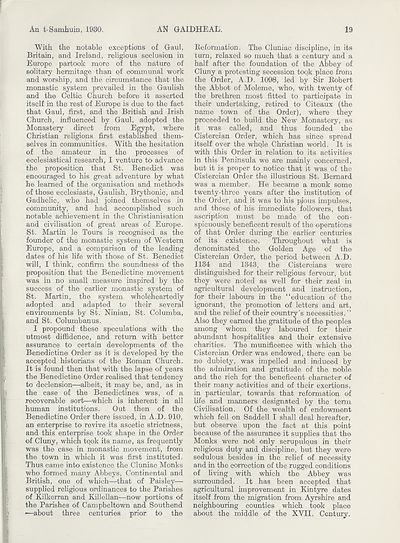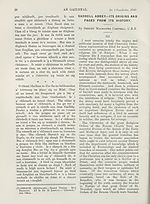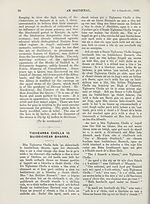An Comunn Gàidhealach Publications > Gaidheal > Volume 26, October 1930--September 1931
(31) Page 19
Download files
Complete book:
Individual page:
Thumbnail gallery: Grid view | List view

An t-Samhuin, 1930.
AN GAIDHEAL.
19
With the notable exceptions of Gaul,
Britain, and Ireland, religious seclusion in
Europe partook more of the nature of
solitary hermitage than of communal work
and worship, and the circumstance that the
monastic system prevailed in the Gaulish
and the Celtic Church before it asserted
itself in the rest of Europe is due to the fact
that Gaul, first, and the British and Irish
Church, influenced by Gaul, adopted the
Monastery direct from Egypt, where
Christian religions first established them¬
selves in communities. With the hesitation
of the amateur in the processes of
ecclesiastical research, I venture to advance
the proposition that St. Benedict was
encouraged to his great adventure by what
he learned of the organisation and methods
of those ecclesiasts, Gaulish, Brythonic, and
Gadhelic, who had joined themselves in
community, and had accomplished such
notable achievement in the Christianisation
and civilisation of great areas of Europe.
St. Martin le Tours is recognised as the
founder of the monastic system of Western
Europe, and a comparison of the leading
dates of his life with those of St. Benedict
will, I think, confirm the soundness of the
proposition that the Benedictine movement
was in no small measure inspired by the
success of the earlier monastic system of
St. Martin, the system wholeheartedly
adopted and adapted to their several
environments by St. Ninian, St. Columba,
and St. Columbanus.
I propound these speculations with the
utmost diffidence, and return with better
assurance to certain developments of the
Benedictine Order as it is developed by the
accepted historians of the Boman Church.
It is found then that with the lapse of years
the Benedictine Order realised that tendency
to declension—albeit, it may be, and, as in
the case of the Benedictines was, of a
recoverable sort—which is inherent in all
human institutions. Out then of the
Benedictine Order there issued, in A.D. 910,
an enterprise to revive its ascetic strictness,
and this enterprise took shape in the Order
of Cluny, which took its name, as frequently
was the case in monastic movement, from
the town in which it was first instituted.
Thus came into existence the Cluniac Monks
who formed many Abbeys, Continental and
British, one of which—that of Paisley—
supplied religious ordinances to the Parishes
of Kilkerran and Killellan—now portions of
the Parishes of Campbeltown and Southend
—about three centuries prior to the
Refonnation. The Cluniac discipline, in its
turn, relaxed so much that a century and a
half after the foundation of the Abbey of
Cluny a protesting secession took place from
the Order, A.D. 1098, led by Sir Robert
the Abbot of Moleme, who, with twenty of
the brethren most fitted to participate in
their undertaking, retired to Citeaux (the
name town of the Order), where they
proceeded to build the New Monastery, as
it was called, and thus founded the
Cistercian Order, which has since spread
itself over the who.le Christian world. It is
with this Order in relation to its activities
in this Peninsula we are mainly concerned,
but it is proper to notice that it was of the
Cistercian Order the illustrious St. Bernard
was a member. He became a monk some
twenty-three years after the institution of
the Order, and it was to his pfous impulses,
and those of his immediate followers, that
ascription must be made of the con¬
spicuously beneficent result of the operations
of that Order during the earlier centuries
of its existence. Throughout what is
denominated the Golden Age of the
Cistercian Order, the period between A.D.
1134 and 1343, the Cistercians were
distinguished for their religious fervour, but
they were noted as well for their zeal in
agricultural development and instruction,
for their labours in the “education of the
ignorant, the promotion of letters and art,
and the relief of their country’s necessities. ’’
Also they earned the gratitude of the peoples
among whom they laboured for their
abundant hospitalities and their extensive
charities. The munificence with which the
Cistercian Order was endowed, there can be
no dubiety, was impelled and induced by
the admiration and gratitude of the noble
and the rich for the beneficent character of
their many activities and of their exertions,
in particular, towards that reformation of
life and manners designated by the term
Civilisation. Of the wealth of endowment
which fell on Saddell I shall deal hereafter,
but observe upon the fact at this point
because of the assurance it supplies that the
Monks were not only scrupulous in their
religious duty and discipline, but they were
sedulous besides in the relief of necessity
and in the correction of the rugged conditions
of living with which the Abbey was
surrounded. It has been accepted that
agricultural improvement in Kintyre dates
itself from the migration from Ayrshire and
neighbouring counties which took place
about the middle of the XVII. Century.
AN GAIDHEAL.
19
With the notable exceptions of Gaul,
Britain, and Ireland, religious seclusion in
Europe partook more of the nature of
solitary hermitage than of communal work
and worship, and the circumstance that the
monastic system prevailed in the Gaulish
and the Celtic Church before it asserted
itself in the rest of Europe is due to the fact
that Gaul, first, and the British and Irish
Church, influenced by Gaul, adopted the
Monastery direct from Egypt, where
Christian religions first established them¬
selves in communities. With the hesitation
of the amateur in the processes of
ecclesiastical research, I venture to advance
the proposition that St. Benedict was
encouraged to his great adventure by what
he learned of the organisation and methods
of those ecclesiasts, Gaulish, Brythonic, and
Gadhelic, who had joined themselves in
community, and had accomplished such
notable achievement in the Christianisation
and civilisation of great areas of Europe.
St. Martin le Tours is recognised as the
founder of the monastic system of Western
Europe, and a comparison of the leading
dates of his life with those of St. Benedict
will, I think, confirm the soundness of the
proposition that the Benedictine movement
was in no small measure inspired by the
success of the earlier monastic system of
St. Martin, the system wholeheartedly
adopted and adapted to their several
environments by St. Ninian, St. Columba,
and St. Columbanus.
I propound these speculations with the
utmost diffidence, and return with better
assurance to certain developments of the
Benedictine Order as it is developed by the
accepted historians of the Boman Church.
It is found then that with the lapse of years
the Benedictine Order realised that tendency
to declension—albeit, it may be, and, as in
the case of the Benedictines was, of a
recoverable sort—which is inherent in all
human institutions. Out then of the
Benedictine Order there issued, in A.D. 910,
an enterprise to revive its ascetic strictness,
and this enterprise took shape in the Order
of Cluny, which took its name, as frequently
was the case in monastic movement, from
the town in which it was first instituted.
Thus came into existence the Cluniac Monks
who formed many Abbeys, Continental and
British, one of which—that of Paisley—
supplied religious ordinances to the Parishes
of Kilkerran and Killellan—now portions of
the Parishes of Campbeltown and Southend
—about three centuries prior to the
Refonnation. The Cluniac discipline, in its
turn, relaxed so much that a century and a
half after the foundation of the Abbey of
Cluny a protesting secession took place from
the Order, A.D. 1098, led by Sir Robert
the Abbot of Moleme, who, with twenty of
the brethren most fitted to participate in
their undertaking, retired to Citeaux (the
name town of the Order), where they
proceeded to build the New Monastery, as
it was called, and thus founded the
Cistercian Order, which has since spread
itself over the who.le Christian world. It is
with this Order in relation to its activities
in this Peninsula we are mainly concerned,
but it is proper to notice that it was of the
Cistercian Order the illustrious St. Bernard
was a member. He became a monk some
twenty-three years after the institution of
the Order, and it was to his pfous impulses,
and those of his immediate followers, that
ascription must be made of the con¬
spicuously beneficent result of the operations
of that Order during the earlier centuries
of its existence. Throughout what is
denominated the Golden Age of the
Cistercian Order, the period between A.D.
1134 and 1343, the Cistercians were
distinguished for their religious fervour, but
they were noted as well for their zeal in
agricultural development and instruction,
for their labours in the “education of the
ignorant, the promotion of letters and art,
and the relief of their country’s necessities. ’’
Also they earned the gratitude of the peoples
among whom they laboured for their
abundant hospitalities and their extensive
charities. The munificence with which the
Cistercian Order was endowed, there can be
no dubiety, was impelled and induced by
the admiration and gratitude of the noble
and the rich for the beneficent character of
their many activities and of their exertions,
in particular, towards that reformation of
life and manners designated by the term
Civilisation. Of the wealth of endowment
which fell on Saddell I shall deal hereafter,
but observe upon the fact at this point
because of the assurance it supplies that the
Monks were not only scrupulous in their
religious duty and discipline, but they were
sedulous besides in the relief of necessity
and in the correction of the rugged conditions
of living with which the Abbey was
surrounded. It has been accepted that
agricultural improvement in Kintyre dates
itself from the migration from Ayrshire and
neighbouring counties which took place
about the middle of the XVII. Century.
Set display mode to:
![]() Universal Viewer |
Universal Viewer | ![]() Mirador |
Large image | Transcription
Mirador |
Large image | Transcription
| An Comunn Gàidhealach > An Comunn Gàidhealach Publications > Gaidheal > Volume 26, October 1930--September 1931 > (31) Page 19 |
|---|
| Permanent URL | https://digital.nls.uk/125152776 |
|---|
| Description | This contains items published by An Comunn, which are not specifically Mòd-related. It includes journals, annual reports and corporate documents, policy statements, educational resources and published plays and literature. It is arranged alphabetically by title. |
|---|
| Description | A collection of over 400 items published by An Comunn Gàidhealach, the organisation which promotes Gaelic language and culture and organises the Royal National Mòd. Dating from 1891 up to the present day, the collection includes journals and newspapers, annual reports, educational materials, national Mòd programmes, published Mòd literature and music. |
|---|---|
| Additional NLS resources: |
|

